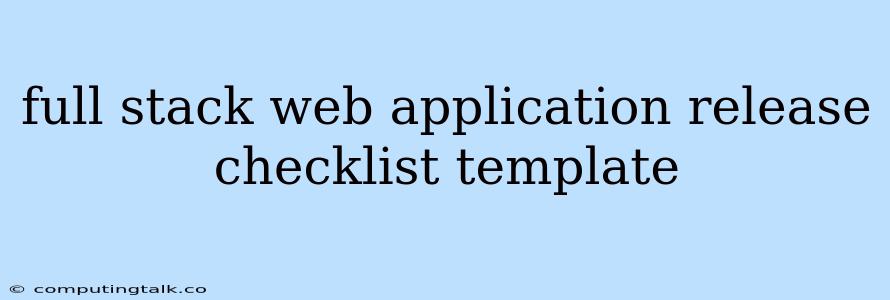A full stack web application release checklist template is an essential tool for ensuring a smooth and successful deployment of your web application. It helps to systematically track all the critical steps involved in the release process, from development to production, minimizing the risk of errors and ensuring a high-quality user experience.
What is a Full Stack Web Application Release Checklist Template?
A full stack web application release checklist template is a comprehensive document that outlines all the tasks that need to be completed before a new version of your web application is released to production. It is a structured guide that helps developers, testers, and operations teams to work together efficiently and ensure that all aspects of the release are covered.
Why Use a Full Stack Web Application Release Checklist Template?
Using a full stack web application release checklist template offers several benefits:
- Reduces Errors: By following a predefined checklist, you can minimize the risk of overlooking critical steps, reducing the chances of bugs, errors, or inconsistencies in the deployed application.
- Ensures Consistency: The checklist ensures that every release follows a consistent process, minimizing variations and promoting standardization across different releases.
- Improves Communication: The checklist provides a clear and concise overview of the release process, facilitating communication and collaboration between different teams involved.
- Saves Time and Resources: By streamlining the release process, you can save time and resources by avoiding unnecessary delays or rework.
- Increases Confidence: A comprehensive checklist builds confidence in the quality and stability of the released application.
Full Stack Web Application Release Checklist Template Components
A typical full stack web application release checklist template consists of the following sections:
Development
- Code Review: Have all code changes been thoroughly reviewed and approved by peers?
- Unit Tests: Have all unit tests been executed and passed successfully?
- Integration Tests: Have all integration tests been executed and passed successfully?
- End-to-End Tests: Have all end-to-end tests been executed and passed successfully?
- Code Coverage: Is the code coverage adequate for all critical functionalities?
- Security Testing: Have security vulnerabilities been identified and addressed?
- Performance Testing: Have performance tests been conducted to ensure the application meets performance requirements?
- Accessibility Testing: Have accessibility tests been conducted to ensure the application is usable by individuals with disabilities?
- Documentation: Is all necessary documentation updated with the new changes?
Deployment
- Staging Environment: Has the application been deployed to a staging environment for testing?
- Environment Configuration: Are all environment variables and configurations correctly set up?
- Database Migration: Have all necessary database migrations been executed successfully?
- Data Backup: Have all critical data been backed up before the deployment?
- Deployment Script: Is there a reliable and automated deployment script?
- Rollback Plan: Is there a plan for reverting to the previous version in case of issues?
Testing & Quality Assurance
- Smoke Tests: Have smoke tests been executed to ensure the basic functionalities of the application are working?
- Regression Tests: Have regression tests been executed to ensure that new changes haven't introduced any unintended bugs?
- User Acceptance Testing (UAT): Have UAT tests been conducted by stakeholders to validate the application's functionality and meet their requirements?
Release & Monitoring
- Release Notes: Are clear and concise release notes created for the new version?
- Release Announcement: Is there a communication plan for announcing the new release to users and stakeholders?
- Monitoring Tools: Are monitoring tools in place to track the performance and health of the application in production?
- Alerting System: Is there an alert system in place to notify the team of any critical issues or failures?
Tips for Using a Full Stack Web Application Release Checklist Template
- Customize the Checklist: Adapt the template to your specific needs and project requirements.
- Collaborate with the Team: Ensure that all teams involved in the release process have access to and understand the checklist.
- Keep it Up-to-Date: Regularly review and update the checklist to reflect any changes in the release process or application architecture.
- Document Decisions: Document any deviations from the checklist and the reasons behind them.
- Review and Improve: After each release, analyze the effectiveness of the checklist and make adjustments based on lessons learned.
Conclusion
Implementing a full stack web application release checklist template is crucial for ensuring a smooth and successful deployment process. By following a structured and comprehensive approach, you can minimize the risk of errors, improve communication, and ultimately deliver a high-quality web application to your users. Remember to customize the checklist to your specific needs, collaborate with your team, and regularly review and improve the process for continuous optimization.
